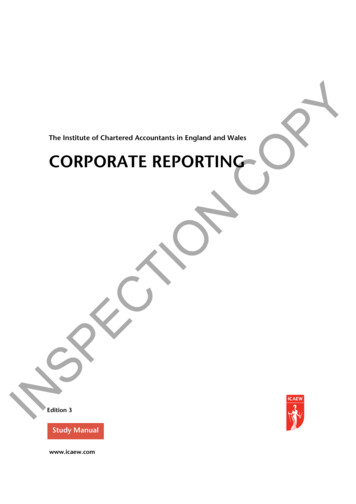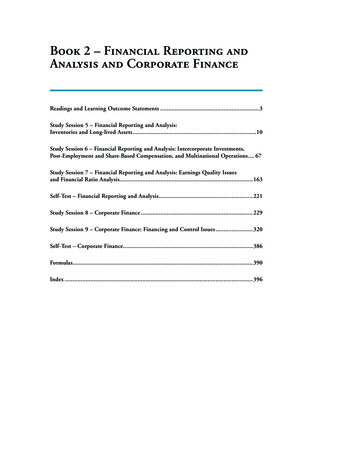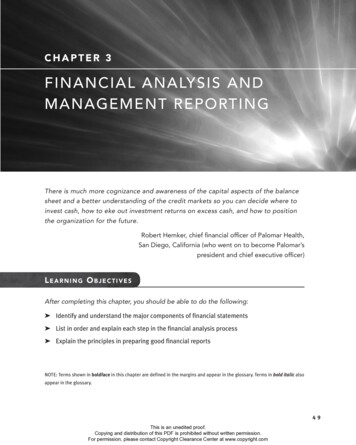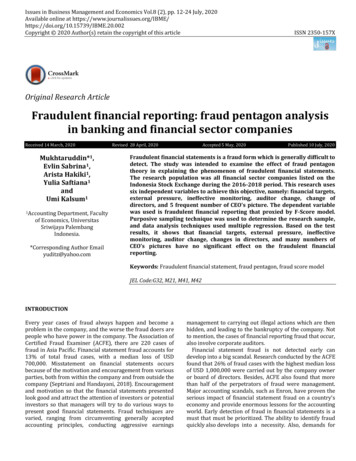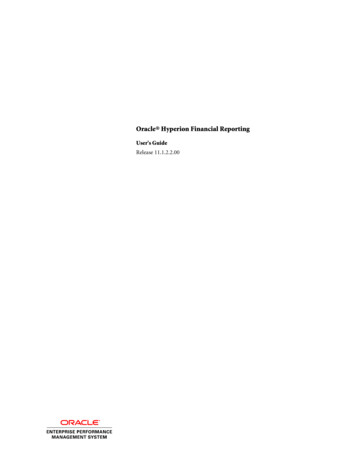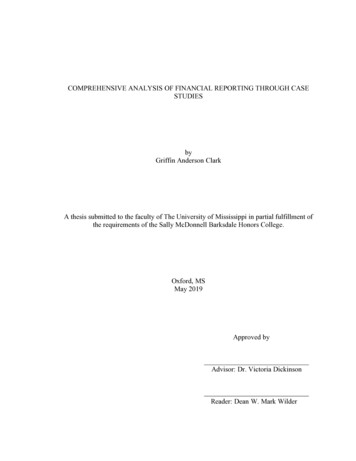
Transcription
COMPREHENSIVE ANALYSIS OF FINANCIAL REPORTING THROUGH CASESTUDIESbyGriffin Anderson ClarkA thesis submitted to the faculty of The University of Mississippi in partial fulfillment ofthe requirements of the Sally McDonnell Barksdale Honors College.Oxford, MSMay 2019Approved byAdvisor: Dr. Victoria DickinsonReader: Dean W. Mark Wilder
2019Griffin ClarkALL RIGHTS RESERVEDii
ABSTRACTGRIFFIN CLARK: Comprehensive Analysis of Financial Reporting Through CaseStudies(Under the direction of Dr. Victoria Dickinson)This thesis covers both fundamental and nuanced issues relating to accounting and, morespecifically, financial reporting. These issues range from cash flow analysis to bankauditing opinions. The thesis is a compilation of twelve case studies assigned by Dr.Victoria Dickinson in the Professional Research and Development Program. From abroader perspective, the insight gained through this thesis is primarily concerned withhow the three fundamental financial statements, the balance sheet, income statement, andstatement of cash flows interact with one another within a given fact set. Transactions,estimates, and adjustments can influence all three financial statements, changing howfinancial statement users perceive a company. Therefore, it is extremely important tounderstand how these items fit into the financial reporting framework.Some of the topics covered within this class include accounting for debt securitiesand financial statement analysis. This thesis also includes various aspects of analyticalreasoning through the application of accounting principles to certain problems within thecase studies. These applications allowed for the development of professional judgementwith respect to certain financial reporting issues as there was not always a right or wronganswer. Rather, students must use the set of rules to argue for a specific outcome given afact pattern. The bank audit case serves as a great example of this application. Studentswere asked to give an opinion on the classification of certain debt securities using a seriesof rules and tests. There was not necessarily a correct answer; however, students had toargue why the security should be given a certain classification. The skills gained here areiii
extremely important for auditors as the entire profession revolves around usingprofessional judgement when analyzing corporate financial statements.In addition, some of the case studies involved the research and development oftechnical skills through various computer applications widely used in the accountingprofession. Research into Python and Microsoft Power BI allowed students to gainfamiliarity with complex yet extremely important programs used in auditing and tax. Thisresearch further enhanced professional development through research into how theseprograms could better help students in their career through task automation or multidimensional financial statement analysis. Furthermore, the creation of balance sheets andincome statements on excel, the most important program used by accountingprofessionals, allowed students to build their technical skills and bridge the gap betweentheoretical concepts and real world applications. A large portion of this class involvedtaking concepts learned in various accounting classes and applying them to actualscenarios. Therefore, this thesis also serves as a culmination of the accountancy degreeby linking concepts to reality.Moving beyond the scope of this thesis, the information and skills obtained duringthe Professional Research and Development Program is crucial for a successful career inauditing or tax. The class allowed students to hone both their problem solving andresearch skills. For many of the cases, the solutions were not always clearly identifiable;therefore, students had to work and research outside of the classroom to solve the issues.In addition, the presentation of the answers in a clean and professional format is anotherapplicable skills for a future career. Being able to adequately explain the issue to others isarguably just as important as the problem solving process. These skills will come intoiv
play in the professional environment as students will be asked to complete assigned workand present the work to management.v
TABLE OF CONTENTSLIST OF FIGURES AND APPENDICESviiCase Study 1: Python1Case Study 2: Rite Aid Corporation10Case Study 3: Merck & Co., Inc.19Case Study 4: State Street Co.25Case Study 5: ZAGG Inc.32Case Study 6: Apple Inc.40Case Study 7: Microsoft Power BI45Case Study 8: Rocky Mountain Chocolate Factory51Case Study 9: Scenario Reflection58Case Study 10: Generic Bank65Case Study 11: Analysis of Cities71Case Study 12: WorldCom, Inc.87vi
LIST OF FIGURES AND APPENDICESCase Study 2: Rite Aid CorporationFigure 2-1 Rite Aid Corporation Amortization ScheduleCase Study 3: Merck & Co., Inc.10171924Figure 3-1 Merck & Co., Inc.’s RatiosCase Study 8: Rocky Mountain Chocolate FactoryFigure 8-1 Rocky Mountain Chocolate Factory General JournalFigure 8-2 Rocky Mountain Chocolate Factory Income StatementFigure 8-3 Rocky Mountain Chocolate Factory Balance SheetFigure 8-4 Rocky Mountain Chocolate Factory Cash Flow InformationCase Study 11: Analysis of Cities5154555657717585Figure 11-1 Income Tax RatesFigure 11-2 Monthly Operating BudgetCase Study 12: WorldCom, Inc.Figure 12-1: WorldCom, Inc. Depreciation Expensevii8791
CASE STUDY 1: PYTHON1
IntroductionWhen I first began diving into this case study, I already had a little knowledge aboutPython as a programming language. However, I had no idea about the extent of Python’scapabilities. From web design, database interfacing, and software development, Python isan all-inclusive programming language. Furthermore, I discovered many uses of Pythonin the business world that could definitely help me become more efficient at dataanalytics. The ease of use and manageable learning curve of this programming languagehas made me want to explore the possibility of learning Python as I move into the earlystages of my career. The purpose of this case was to explore the history of Python and itsbusiness uses and to apply its widespread functionalities in potential business scenarios.All of these items are addressed in the following sections.History of PythonPython was developed during December 1989 by Guido van Rossum as a scriptinglanguage for a distributed operating system, Amoeba. Named after the British comedygroup Monty Python, Python originated as one of van Rossum’s side hobbies beforegaining popularity in the early nineties and eventually establishing itself as one of themost widespread and popular programming languages today. Python’s seamless supportacross multiple platforms as well as clear syntax and accessibility proved vital inattracting new programmers to its user base. Although Python underwent a few updatesto its source code such as Python 2.0 being released by BeOpen Python Labs team in2000, this open source programming language has remained focused on communityoriented development and transparency.2
Purpose of Python in business decisionsOne of the most enticing characteristics of Python is its purpose; programmers usepython for web and internet development, software development, data analysis, andbusiness applications. Python language runs on any operating system such as Mac OS,Windows, or Linux. In general, Python supports a variety of business decisionsdepending on its intended use; for example, individuals use Python to interface with SQLdatabases to pull relevant information from the database and make decisions based onthat information. Furthermore, individuals use Python to build enterprise resourceplanning (ERP) systems to integrate business decisions across entire corporations. Inorder to fully utilize the functionality of Python, businesses should have databasemanagement systems in place if they wish to use Python for database interfacing.Businesses also should have installed integrated development environment (IDE)programs on their operating systems to enable large scale data processing and Pythonlanguage editing.Special skills needed to use PythonThe skills necessary to use Python revolve around the understanding of the languageitself. As a programming language, Python follows a very specific syntax structure. Fordatabase interfacing and ERP development, users must have a working knowledge ofdatabase design coupled with Python’s function keywords to perform specific tasks.Functions such as “create database”, “import”, and “insert into” are crucial functions inmanipulating and editing data to fit an individual’s business decision needs. Furthermore,3
users must have high level understanding of how databases and applications within thecorporation interact with each other as well as the flow of data. A student’s best bet foracquiring these skills is simply to practice. As a great programming language forbeginners, a student looking to gain Python programming skills should download an IDEalong with the latest version of Python from Python.org; after downloading the necessarytools, the student should familiarize himself/herself with the basic syntax structure ofPython and create a small programming project to practice these skills. For example, astudent could practice pulling information from a website with published applicationprogramming interfaces (API) into their own IDE using “get” and “import” requests.Auditing scenarios for PythonIn auditing, if I were tasked with verifying the accuracy of sales revenues on the financialstatements, I would need to comb through the financial records of the company within theERP system to ensure that revenues are not misstated. To do so, I would use python topull all of the revenue records relevant to my needs from the company’s database andcross check this information with the financial statements. This method would serveparticularly useful for large companies with vast datasets and complex financialstatements. It would be much for efficient for a program to pull all of the necessaryrevenue information from the datasets using predefined parameters rather than having tomanually look through each database record in the ERP.With regards to data integrity, many problems arise with the input of data into anERP. Incorrect information being entered into the company’s system can result in invalidand useless information being sent to government agencies such as the SEC. If I were in4
internal audit, I would use Python to develop an application that would search throughthe company’s data for invalid and incorrectly entered data. Due to Python’s supportacross multiple platforms, it would be feasible to interface this data validation applicationwith the ERP and quickly find errors in the data due to careless or rushed employees.Here, Python would create a more effective data environment and reduce inefficienciesresulting in incorrect data being published or sent to various stakeholders.Another unique use of Python in auditing could be for information technologyauditing. If I were an IT auditor looking to assess a company’s IT security, I could usePython to attempt to gain unauthorized access to a company’s data. Using Python, Iwould interface with the database management system such as SQLite or MySQL andattempt to use SQL injections to gain access to data I am not authorized to see (thisscenario would most likely come about from a disgruntled or rogue employee). If thecompany has effective security procedures and database protection, I would not be able toaccess this data. Therefore, using Python code, coupled with SQL commands, I could testthe effectiveness of IT security within a company and help the company potentially avoidsevere losses of data.Tax planning scenarios for PythonSuppose I am in charge of reviewing our company’s inventory accounting with regards totax implications. Currently, our team uses the FIFO accounting method to valueinventory. As prices of the inventory we buy rise throughout the year, our cost of goodssold is low and our taxes are higher. Our company wants to know what the taximplications would be if we switched to LIFO. Without any historical data on the LIFO5
method, I would need to pull the inventory data used during this and previous years andcreate a script using Python and simple “if” and “else” arguments. This script wouldanalyze the inventory and sales records throughout the year and reorganize the cost ofgoods sold as if the company was using LIFO. Using this script, the company would beincreasing tax efficiency if the programs revealed a historical trend of lower taxes underLIFO. Furthermore, it would be much more efficient to automate the process ofreorganizing inventory records to reflect a different inventory method as opposed tomanually doing it.In another scenario, I am a tax accountant with a variety of individual clientsranging in annual income from 200,000 to 3,000,000. Due to the complex tax bracketsthat call for varying income taxes for different salaries, I have to manually compute thetaxes for each of my clients. However, using Python I can write a script thatautomatically calculates my client’s income taxes based on a set of rules that revolvearound the tax bracket percentages. If my client’s income goes up or down based onpromotions or demotions, I can quickly calculate his or her new taxes. If the tax codechanges, I do not have to spend time relearning the new percentages; I can just update therules for my python script to reflect the new tax code. Python saves me time doingmeaningless calculations and allows me to focus my efforts on the other aspects of taxplanning.In one scenario with regards to tax planning, I am a financial planner whose clientwants to withdraw a sum of money from his individual retirement account (IRA) beforethe age of 60. Because of this, my client will face certain tax penalties associated with hiswithdrawal. Using Python, I am able to write a script that will calculate the most efficient6
amount of money to withdraw from his account in order to minimize the tax penalty andallow the remaining money in his IRA to continue compounding. This script will also runconcurrent analyses that take into account the future value of money both withdrawnfrom the account, the tax penalty, and the money in the IRA. This script will hopefullyhelp my client visualize the amount of money he could save if he kept his money in theIRA.Financial statement analysisIn this scenario, I am a first year financial planning and analysis analyst who is chargedwith reviewing our company’s financial statements from the past 30 years to compare ourcurrent year operating costs to historical trends. Using Python, I am able to interface withour company’s database management system and not only instantly pull the operatingexpenses from the past 30 years, but also arrange them from highest costs to lowest costs.In addition, I can also exclude years during which the company heavily expanded toremove potential outliers in operating costs and see how the company is performingagainst historical benchmarks.In another scenario, I am a mid-level manager of a private company that islooking to potentially go public. I am charged with coming up with a ball park estimateof how much our company should be valued per share. Thankfully, quite a fewcompanies in our industry have already gone public and have posted their prior yearfinancial statements as well as initial stock valuations on their websites. I can usePython’s “get” and “import” requests to perform a task called HTML scraping to transferthis data from their website onto my computer. Once I have the necessary financial data7
and stock valuations from the similar companies, I can use Python to cross reference ourcompany’s financial statements and find out which public companies in our market hadthe most similar financial metrics at the date of their initial public offering. This data willallow me to get obtain a decent estimate of how much I believe our company should bevalued. Python will allow me to perform the very complex task of company valuationmust faster and efficiently than through traditional means such as financial modeling.In the last scenario, I am a financial planning and analysis analyst in charge ofcompiling all of the administrative expenses for this quarter into a single report for thequarterly income statement. Due to the size of the company, there are thousands ofindividual expense reports that must be compiled from the database. Using Python andthe database management system, I am able to grab all of the expense reports that relateto administrative expenses and arrange them into a single table to be sent to management.With the help of Python, I do not have to comb through thousands of expense reports inour database to find the ones relating to administration. Python saves me and thecompany precious time and allows me to more efficiently do my job.Why our company should employ PythonDear Manager,With every new development for a company, obvious initial fixed costs will be incurred;the implementation of Python and employee training is no different. Although Python hasa higher initial learning curve than most tools, the long lasting benefits of employing sucha multifunctional tool in our company will far surpass its initial costs. Although training8
employees to use a programming language may sound complex and time consuming,Python’s easy and clean syntax and simple, makes it a great candidate for beginners.I believe the introduction of Python into our company will bring about these threechanges in the way our company operates. Using Python, we can rely on our employeesto obtain data from our database management system faster than before. In addition, wecan develop departmental applications and software using Python to both automate timeconsuming processes and perform data analytics at an exponentially faster rate. Finally,by training our employees to use a programming language, we are adding unparalleledknowledge capital to this company while allowing our employees to hone their criticalthinking and problem solving skills. An extremely knowledgeable and flexible workforcewill undoubtedly bring a positive change to this company in the coming years.-Griffin ClarkReferencesA Brief History of Python. (n.d.). Retrieved January 30, 2018, istory-pythonApplications for Python. (n.d.). Retrieved January 30, 2018, fromhttps://www.python.org/about/apps/Applications of Python in the Real World. (2016, December 29). Retrieved January 30,2018, from ython-in-real-world/Shethna, B. J. (2017, October 05). Basic Concepts of Python Programming (BeginnersGuide). Retrieved January 30, 2018, from -tutorial/9
CASE STUDY 2: RITE AID CORPORATION10
IntroductionAlthough we have been learning a great deal about bonds and notes payable inintermediate accounting, we have not had the ability to dive into financial statements indepth. This case allowed me to comb through the actual financial statements of acompany and uncover the details behind Rite Aid’s debt. I found this case to beextremely insightful as it allowed me to apply classroom information to real world use. Inthis case, I discuss the various types of debt taken on by Rite Aid and the debt’s potentialimplications moving forward. I also prepare journal entries and financial statementanalysis on three specific notes, uncovering every possible detail.Types of debt, indebtedness, and credit agreementsSecured debt occurs when the issuing company ties certain assets to the debt as collateral.Lenders are able to take the company’s assets if the issuing company falls behind onpayments or cannot pay the debt at all. Unsecured debt does not have any underlyingassets as collateral and are generally riskier in nature. Rite Aid must distinguish betweensecured and unsecured debt as these two types of debts carry different consequences inthe case of defaulted debt, levels of importance to stakeholders reading these financialstatements, and risks involved in the capital structure of Rite Aid. A “guaranteed” debtoccurs when a third party, the “guarantor”, promises to fulfill the debt obligation of theborrow if the borrow defaults. According to note 11, wholly-owned subsidiaries of RiteAid corporation have provided the guarantee for some of its unsecured debt. Rite Aidmight have many different types of debt because Rite aid was not able to source all of itscapital needs from one lender. Lenders might only be able to loan Rite Aid restricted11
amounts of money; therefore, Rite Aid has to shop around various lenders over time tosource its needed capital. Furthermore, these loans have different interest rates as thelenders offer different credit terms to Rite Aid. As Rite Aid takes on debt over time,interest rates in the market are certain to fluctuate, leaving the corporation with varyinglines of credit.Rite Aid total debtAs seen in note 11, Rite Aid currently has 6,370,899 in total debt. This number can bereconciled by adding up all of the components of Rite Aid’s debt in the balance sheet.Rite Aid’s debt consists of its currently maturing portions of debt 51,502, its long termdebt less current maturities of 6,185,633, and its lease obligations less current maturitiesof 133,764. These three portions of debt add up to 6,370,899 (equal to the total debtreported in the Indebtedness and Credit Agreement section). Rite Aid’s currentlymaturing portions of debt consisting of 51,502 is due within the coming fiscal year.7.5% Senior secured notes due March 2017The face value of the 7.5% senior secured note due March 2017 is 500,000. We knowthis amount is 500,000 as there is no “amortized discount”. Therefore, the face value(principal) of the bond will remain the same each year until maturity; the marketrate of 7.5% is equal to the stated rate of 7.5%.12
Journal entry to record the issuance of the notes:dr. Cashcr.500,000Notes Payable500,000Because the note was issued at par value, the amount of cash received is equal to the facevalue of the note. No discount or premium account is used for this journal entry. Theissuance of notes payable will cause an increase in both assets and liabilities with noeffect on net income.Journal entry to record the annual interest expense:dr. Interest Expensecr.37,500Interest Payable37,500The annual interest expense is found by multiplying the stated rate on the note by the facevalue of the note. Therefore, 7.5% x 500,000 37,500. The recording of annualinterest expense causes no effect on assets, an increase in liabilities (Interest Payable),and decrease in net income (through the Interest Expense account).Journal entry when the notes mature in 2017dr. Notes Payablecr.500,000Cash500,000When the notes mature, Rite Aid must pay the principal amount of the notes back to thelender; therefore, it must pay the full 500,000. In addition, assets (Cash) and liabilities(Notes Payable) decrease with the retirement of this debt, and net income is not affected.13
9.375% Senior notes due December 2015The face value of the 9.375% senior notes is 410,000. The carrying value of these notesis 405,951. The carrying value can be found by subtracting the unamortized discount asof 2010 from the face value. Therefore, 410,000 - 4049 405,951. We know 4049 is2010’s unamortized discount as it is listed first in the parentheses, maintaining congruitywith the carrying values of the notes to the right. These two values differ because thenotes were issued at a discount; thus, the bond was issued below its face value. Thediscount will be amortized over the course of the note’s life until the carrying valueequals face value at maturity. During 2009, Rite Aid paid 38,438 for the cash portion ofthe interest expense. This value can be found by multiplying the principal of the note bythe stated rate and the time period (Which is 12 months/ 12 months due to the annualinterest payments). 410,000 (principal) x 9.375% (stated rate) 38,438. In order tofind the total interest expense, we must add the cash interest expense and the change inunamortized discount from 2009 to 2010. To find the change in unamortized discount,you simply have to subtract the carrying value of the note in 2010 from the carrying valueof the note in 2009; 405,951 (2010) - 405,246 (2011) 705. Therefore, the totalamount of interest expense is equal to 39,143. 38,438 (cash portion) 705 (change inunamortized discount) 39,143.14
Journal entry to record interest expense on these notes for fiscal 2009dr. Interest Expense39,143cr.Discount on Notes Payable705cr.Cash38,438The issuance of these notes will cause an increase in assets (Cash) and liabilities (NotesPayable). The recording of interest expense causes a decrease in assets (Cash), anincrease in liabilities, and a decrease in net income (through the Interest Expenseaccount). The increase in liabilities occurs due to the decrease in the Discount on NotesPayable account which is a contra liability account.The total rate of interest recorded for fiscal 2009 can be found by dividing total interestexpense for the year by the carrying value of the notes payable at the beginning of theyear. 39,143 (total interest expense) divided by 405,246 (carrying value at beg. of year 9.659%. This logically makes sense as the effective (market) rate of 9.659% is higherthan the stated rate of 9.375%. This is a staple characteristic of notes issued at a discount.9.75% notes due June 2016: Issued June 30, 2009, Annual Interest payable June 30thJournal entry to record the issuance of these notes at 98.2%dr. Cash402,620dr. Discount on Notes Payable7,380cr.Notes Payable15410,000
In order to accurately write these journal entries, we must first calculate the cashproceeds from the issuance of these notes. The notes were issued at 98.2% of par;therefore, the cash proceeds from this issuance is 98.2% of the face value of the notes. 410,000 * 98.2% 402,620. Thus, the cash proceeds from these notes are 402,620and the Discount on Notes Payable is simply the face value of the note ( 410,000)subtracted by the cash proceeds ( 402,620) 7,380. The issuance of these notes causesan increase in assets (Cash), an increase in liabilities ( 410,000), and no effect on netincome. It is important to note that because the notes were issued at a discount, a contraliability account is established as well.In order to calculate the effective interest rate, we must use excel’s “rate”function. Once we are in excel, we type out Rate(nper, -cash interest payments, cashproceeds, - face value). We know the number of periods is the amount of year until thenotes mature which is in 2016. Thus, 2016 minus 2009 equals 7 years to maturity. Weknow the cash interest payments can be found by multiplying the principal ( 410,000) bythe stated rate (9.75%) and the time (12/12) 39,975. We also know that the cashproceeds previously calculated is 402,620. Lastly, the face value of the note is 410,000.It is important to note the positive and negative signs in the function represent cashinflows and outflows relative to the issuer. When we plug these numbers in, our functionlooks like this: Rate(7, -39975, 402620, -410000). This function gives us the effectiveinterest rate of 10.12%. As seen in Figure 2-1 is the amortization schedule for the 9.75%senior notes.16
Figure 2-1: Rite Aid Corporation Amortization ScheduleDateCash InterestPaymentInterest ExpenseDiscountAmortization6/30/09Carrying ValueEffective InterestRate 402,620.006/30/10 39,975.00 40,750.00 775.00 403,395.0010.12%6/30/11 39,975.00 40,828.44 853.44 404,248.4410.12%6/30/12 39,975.00 40,914.82 939.82 405,188.2610.12%6/30/13 39,975.00 41,009.94 1,034.94 406,223.2010.12%6/30/14 39,975.00 41,114.69 1,139.69 407,362.8910.12%6/30/15 39,975.00 41,230.04 1,255.04 408,617.9310.12%6/30/16 39,975.00 41,357.07 1,382.07 410,000.0010.12%Journal entry to accrue interest expense on February 27, 2010:dr. Interest Expense27,167cr.Discount on Notes Payable517cr.Interest Payable26,650In order to find the correct amounts to credit Interest Payable and Discount on NotesPayable, we must first consider the fact that these amounts will be accrued after 8 monthsrather than a full year. Therefore, the time period to multiply our annual Interest Payableand Discount account is 8 months divided by 12 months. Therefore, we can take theannual cash interest payment for 2010, 39,975, and multiply it by (8/12) to get 26,650.In addition, we can find our discount for to accrue by taking the annual discountamortization for 2010, 775, and multiplying it by (8/12) to get 517. The accrual of17
interest expense results in no effect to assets, an increase in liabilities (Interest Payable),and a decrease in net income (through the Interest Expense account).Based on the table above, the net book value of the notes at February 27, 2010would be 403,137. This number can be found by adding the decrease in the Discount onNotes Payable of 517 to the beginning of year carrying value of 402,620. Thus, 402,620 517 403,137.18
CASE STUDY 3: MERCK & CO., INC.19
IntroductionThis case study was primarily concerned with stockholder’s equity and the various waysa company such as Merck & Co., Inc. can influence its equity capital structure. The mainitems addressed in this case are company shares and dividends. More specifically, thecase dives into understanding the numbers behind Merck & Co., Inc.’s issued andoutstanding shares by analyzing the balance sheet, statement of stockholder’s equity, andstatement of cash flows. One of the main components of this case is analyzing howtreasury stock actually decreases a company’s outstanding shares and subsequentlyimproving profitability ratios. This is imme
financial statement users perceive a company. Therefore, it is extremely important to understand how these items fit into the financial reporting framework. Some of the topics covered within this class include accounting for debt securities and financial statement analysis

